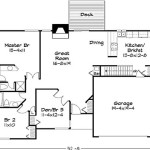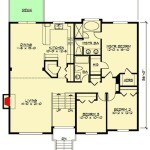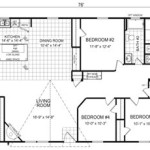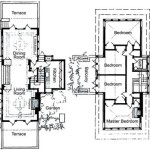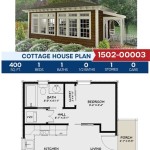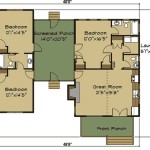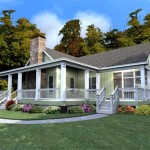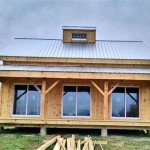Exploring the Charm of English Country Home Floor Plans
English country home floor plans evoke a sense of timeless elegance, comfort, and connection to nature. These designs, often characterized by their practicality, warmth, and understated sophistication, have remained a popular choice for homeowners seeking a retreat from the hustle and bustle of modern life. The enduring appeal lies in their ability to blend classic architectural elements with modern living requirements, creating spaces that are both functional and aesthetically pleasing. Understanding the core elements of these floor plans allows individuals to appreciate their inherent value and to adapt them to their specific needs and preferences.
The design philosophy behind English country homes prioritizes livability and a seamless integration with the surrounding landscape. This is reflected in the layout, material choices, and attention to detail that defines these homes. Unlike more formal architectural styles, English country homes embrace a sense of informality and unpretentiousness, fostering a relaxed and welcoming atmosphere. The floor plans typically emphasize natural light, open spaces, and a strong connection to the outdoors, blurring the lines between the interior and exterior environments.
Key Features of English Country Home Floor Plans
Several distinct characteristics define the typical English country home floor plan. These features are often interwoven, contributing to the overall aesthetic and functional appeal of the design.
1. Emphasis on Natural Light and Views: One of the hallmarks of English country home floor plans is the strategic placement of windows and doors to maximize natural light and provide picturesque views of the surrounding landscape. Large windows, often incorporating multiple panes, are common, allowing ample sunlight to flood the interior spaces. These windows are frequently positioned to capture the best possible views, whether it's a sprawling garden, rolling hills, or a tranquil lake. The use of French doors leading to patios and gardens further enhances the connection between the interior and exterior, creating seamless transitions between living spaces.
The orientation of the house is also carefully considered to optimize sunlight exposure throughout the day. Living rooms and dining areas are often positioned to take advantage of morning or afternoon light, while bedrooms may be oriented to capture softer, more diffused light. Skylights can also be incorporated into attics or hallways to further enhance the natural light within the home.
2. Functional and Flexible Living Spaces: English country home floor plans prioritize functionality and flexibility, creating spaces that can adapt to a variety of needs. Open-plan living areas, where the kitchen, dining room, and living room flow seamlessly into one another, are increasingly popular, providing a sense of spaciousness and promoting social interaction. However, traditional floor plans may also incorporate more defined spaces, such as separate drawing rooms or libraries, offering opportunities for privacy and quiet contemplation.
The kitchen is often the heart of the home, designed as a warm and inviting space for cooking, eating, and gathering. Large islands, farmhouse sinks, and ample storage are common features, reflecting the importance of functionality in the kitchen design. Mudrooms or utility rooms are also often incorporated near the entrance, providing a practical space for storing coats, boots, and other outdoor gear.
Bedrooms are typically designed as comfortable and private retreats, with en-suite bathrooms and walk-in closets. Guest bedrooms are often located on a separate wing of the house, providing privacy for both the hosts and their guests. The overall layout is designed to maximize efficiency and minimize wasted space, creating a home that is both functional and comfortable.
3. Use of Natural Materials and Textures: The use of natural materials and textures is a defining characteristic of English country home floor plans. These materials contribute to the overall warmth, charm, and timelessness of the design. Exposed beams, hardwood floors, stone fireplaces, and brick walls are common features, creating a sense of rustic elegance. These materials are often sourced locally, further enhancing the connection to the surrounding environment.
The incorporation of natural textures, such as linen, wool, and cotton, adds to the overall comfort and visual appeal of the interior spaces. These textures are often used in upholstery, curtains, and rugs, creating a layered and inviting atmosphere. The use of handcrafted details, such as hand-painted tiles or hand-carved moldings, also adds to the unique character and charm of the home.
The color palette typically consists of muted earth tones, such as creams, beiges, browns, and greens, reflecting the natural colors of the surrounding landscape. These colors create a sense of calm and serenity, enhancing the overall sense of relaxation and comfort. Accents of bolder colors, such as blues or reds, may be used to add visual interest and personality to the space.
Adapting English Country Home Floor Plans to Modern Living
While English country home floor plans are rooted in tradition, they can be easily adapted to meet the needs of modern living. This involves incorporating contemporary technologies, modern design elements, and sustainable building practices while maintaining the overall aesthetic and charm of the original design.
One common adaptation is the integration of smart home technology, such as automated lighting, temperature control, and security systems. These technologies can enhance the comfort, convenience, and energy efficiency of the home without compromising its traditional character. Modern kitchens and bathrooms can also be seamlessly integrated into the floor plan, incorporating contemporary appliances, fixtures, and finishes while maintaining the overall aesthetic of the design.
Sustainable building practices are also increasingly being incorporated into English country home floor plans. This includes the use of energy-efficient windows and insulation, solar panels, and rainwater harvesting systems. These practices not only reduce the environmental impact of the home but also lower energy costs and improve indoor air quality.
The floor plan itself can also be adapted to meet the specific needs of the homeowner. This may involve adding a home office, a media room, or a gym. The key is to integrate these additions seamlessly into the existing design, maintaining the overall flow and functionality of the home.
Interior Design Elements in English Country Homes
The interior design of an English country home plays a vital role in completing the overall aesthetic and enhancing its charm and character.
Furniture: Furniture choices lean toward comfortable, well-worn pieces with a mix of antique and modern styles. Overstuffed sofas, armchairs with floral patterns, and sturdy wooden tables are common. Antique furniture, especially pieces with history and character, are often incorporated to add a sense of age and authenticity. The furniture arrangement typically emphasizes functionality and comfort, creating inviting spaces for relaxation and conversation.
Textiles and Fabrics: Textiles and fabrics play a crucial role in creating a warm and inviting atmosphere. Floral prints, plaids, and stripes are frequently used, adding color and pattern to the space. Natural fabrics, such as linen, cotton, and wool, are preferred for their comfort and durability. Layering textures, such as combining a knitted throw with a velvet cushion, adds depth and visual interest to the room.
Accessories: Accessories are used to personalize the space and add character. Antique mirrors, family photos, and collections of china or pottery are common. Fresh flowers, plants, and herbs are often used to bring the outdoors in, adding a touch of natural beauty. Lighting fixtures, such as chandeliers, sconces, and table lamps, are carefully chosen to create a warm and inviting ambiance.
Color Palette: As previously mentioned, the color palette typically consists of muted earth tones, reflecting the natural colors of the surrounding landscape. These colors create a sense of calm and serenity, enhancing the overall sense of relaxation and comfort. Accents of bolder colors, such as blues, reds, or yellows, may be used to add visual interest and personality to the space. Wallpaper with floral or botanical motifs is also a popular choice, adding a touch of traditional elegance to the room.
The Enduring Appeal of English Country Homes
The enduring appeal of English country home floor plans lies in their ability to blend timeless elegance with modern living requirements. These homes offer a sanctuary from the stresses of modern life, providing a comfortable and inviting space to relax, entertain, and connect with nature. The emphasis on natural light, functional living spaces, and natural materials creates a warm and welcoming atmosphere that is both aesthetically pleasing and conducive to well-being. By understanding the key elements of these floor plans, individuals can appreciate their inherent value and adapt them to their specific needs and preferences, creating a home that is both beautiful and functional for years to come. The principles of the English country home continue to inspire homeowners seeking a connection to tradition, comfort, and the beauty of the natural world.

English Mansion House Plans From The 1800s Country Floor Plan

English Country Style Tudor House Plans With 4 Bedrooms

Magnificent English Country Home Plan 12030jl Architectural Designs House Plans

English Cottage House Plans Storybook Style

On English Country Houses House Floor Plan Castle Plans Manor

Luxury European Manor House Plans And Cau

Architectural Print English Cottage Architecture Plans And Prints Vintage House Sims

English Country Manor 15878ge Architectural Designs House Plans

English Country Style Tudor House Plans With 4 Bedrooms

European House Plan 7 Bedrooms 4 Bath 7567 Sq Ft 59 111 Country Style Plans Monster Castle

